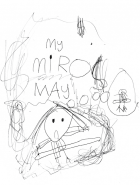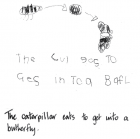You are here:
The first year

Starting school
Starting school
Children’s participation in language and literacy practices at home and in early childhood settings means that they all bring literacy knowledge, skills, and attitudes to their school learning. These are wide-ranging and diverse, reflecting the children’s varying social and cultural contexts. Some of the knowledge, skills, and attitudes that students have will specifically support their transition into school literacy.
McNaughton (2002) explains that becoming expert in the language of the classroom includes learning about the language used as the medium of instruction, because much of what is taught is conveyed verbally, through questioning, directing, prompting, commenting, and evaluating. In order to succeed at school, students need to learn the vocabulary and sentence structures that teachers use and to understand how those words and sentences are used...
Learning through Talk: Oral Language in Years 1 to 3, page 20
Children’s oral language provides a foundation for their reading and writing at school. Their oral language knowledge, skills, and attitudes will continue to be extended by the oral language practices of the classroom as well as by the children’s developing expertise in reading and writing.
The oral language foundation that supports children’s school reading and writing includes:
- curiosity about oral language and a willingness to experiment with it, for example, by playing with rhyme and alliteration
- a wide oral vocabulary of nouns and verbs and also many adjectives and prepositions
- a willingness, and the confidence, to talk about things happening now, in the past, and in the future
- the ability to retell an experience, an event, or a known text
- an awareness of rhyme and of words that start with the same sound, along with the ability to hear and distinguish some other phonemes in spoken words.
Children’s prior experience with written texts provides a good starting point for their formal reading and writing instruction. When they start school, most children will:
- respond to texts in ways that demonstrate engagement (for example, children laugh at funny bits, empathise with a character, join in, ask questions, and express opinions)
- “read” very familiar stories by reciting them
- use illustrations to “read” a story
- enjoy returning to familiar books or listening to stories over and over again.
Such experiences are part of developing a positive attitude towards language and literacy. In addition, most children’s engagement with written texts will have enabled them to acquire some specific knowledge and skills for reading, including:
- the ability to read their own name and also some familiar signs and symbols from their environment (such as logos, brand names, and cultural symbols)
- an awareness of some concepts about print (for example, they hold a book the right way up, and they know that a book is read from front to back1)
- the ability to identify the first letter of their name and some other letters.
When they start school, children enjoy “writing” for a variety of purposes and they can “read” their story or text to another person. They may “write” by making purposeful marks that are not recognisable as letters or words. When children “read” their own “written” stories, they demonstrate that they know what writing is and that they can hold an idea in their head long enough to retell the story.
Many children will also have mastered specific skills that support writing, for example:
- they write their own name using the correct letters in the correct order
- they form some other letters correctly
- they can securely hold a pencil, crayon, or other writing and drawing tool.
During the first interview Alex and Iain, Miro’s mum and dad, brought one of Miro’s drawings out ...
Alex ... explains to Yvette [Miro’s early childhood education teacher] how the drawing came about and how Miro responded when asked what her drawing was about:
“Miro goes to the gym on a Monday, and she’s meant to hoist herself up to the bar and then spin around, and she just couldn’t do it. She wouldn’t do it, so she drew this yesterday. And I just said to her today, ‘What’s this all about?’, and she said, ‘I don’t know how to swing over the bar at the gym.’”
Yvette asks: “Is that a thought bubble?”
Alex responds: “Yeah, that’s a thought bubble. I showed her how to do those. A few weeks ago ... we had this conversation about ‘Do dogs think?’ and ‘What do dogs think?’ ... and how people think and how people speak, so there’s speech bubbles and thought bubbles. So she’s obviously used that, and I said ‘What’s that?’ and she said, ‘That’s me thinking about falling off the bar.’ ... You’ve got the grumpy face, because she’s there at the bar and she doesn’t know what to do.” ..Miro’s drawing, “I don’t know how to swing over the bar at the gym.”
Later ... Yvette writes:
“I was ‘blown away’ with this drawing. Here Miro was thinking about thinking and representing this through her artwork – a symbolic representation of her metacognition! ... This drawing was a catalyst for a shift in thinking for myself, in terms of how I saw Miro as a communicator and the role that drawing was having for her as an active meaning maker.”
Wadestown Kindergarten’s Centre of Innovation Research, 2009, pages 38–40
The kinds of knowledge and skills described above are presented here simply as examples of some of the prior learning that can support students’ transition into school literacy. These examples of what some students may bring with them to school are not intended to be “misconstrued into the use of narrow and inappropriate skill and drill activities by early childhood educators, which will not necessarily help children to develop an interest in literacy” (Makin, Jones Diaz, and McLachlan, 2007, page 21).
Research shows that teaching practice is more effective when the learning context is meaningful to the learner. Ka Hikitia emphasises (on page 20) that all teachers need to gain an understanding of students’ cultural identities, integrate this understanding into their programmes, and use it to help shape the learning experiences of individual students.
In the first year of school
In the first year of school
Students begin reading and writing from their first day at school. Effective teachers build on the literacy knowledge, skills, and attitudes that students bring to their school learning.
Much of the school day revolves around literacy. In addition to shared and guided reading and writing, teachers support their students’ literacy learning with a rich mix of approaches, including language experience and frequent reading to students. They provide many opportunities for students to read and write independently and to engage in purposeful literacy tasks.
When they start school at age five, children will bring to their school learning the literacy foundations and diverse knowledge and experiences that they have gained from participation in their various social and cultural contexts.
Oral language
Focused teaching and many opportunities to engage in talk help students’ oral vocabularies to keep expanding rapidly. Students enjoy identifying and using new words, phrases, and language patterns that they discover in the books and poems they hear or read. They are constantly refining their ability to aurally distinguish sounds in spoken words.
Students use talk to organise and clarify their ideas, and they can offer opinions and responses about the texts they read and hear. They use an increasing variety of verb forms correctly, including irregular past-tense forms, and they draw on their understanding of grammatical structure when they read and write. They develop confidence in ways of talking and listening that are important for their learning at school, such as asking questions and participating in discussions. They can recount an experience or retell a story clearly and logically, with some awareness of the likely needs of the listener. With prompting, they can draw on this awareness when writing for an audience.
Students are becoming aware of some of the differences between spoken and written language. They can use and understand many more words than they can read or write.
Reading
The Ready to Read series is the core instructional reading series. Ready to Read books are carefully levelled and provide a gradient of difficulty to support students in developing effective reading processing systems. Texts designed for students to use in the first year are relatively short, with clear storylines, and use mostly familiar vocabulary and simple sentence structures. As students read these texts, teachers help them to draw on their oral language, and on understandings gained from their writing, as they acquire and consolidate basic reading skills and knowledge of letters and sounds. Students learn how to make meaning of and think critically about increasingly challenging texts. Initially, teachers provide a high level of support, but they adapt this scaffolding carefully as their students gain control over a range of reading processing and comprehension strategies.
Although students progress at different rates, they all need to be at or near Yellow level after six months of instruction in order to reach the goal of reading at Green level by the end of the first year of school. The intention is that students will spend just long enough at each reading level for teachers to observe and confirm that appropriate processing behaviours are in place. Students have many opportunities for independent reading to strengthen their reading processing systems.
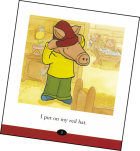
From Look at Me by Miriam Macdonald, Ready to Read (Magenta)
As soon as students start school, they begin reading texts at Magenta level. At this level, they need to:
- develop early concepts about print, such as the ideas that the print carries the message and that print is read from left to right1
- expect a text to make sense and sound right
- gain control over one-to-one word matching.
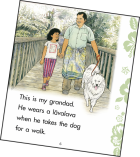
From Lāvalava by Lino Nelisi, Ready to Read (Red)
At Red level, students are learning how to process print. They make meaning of text by applying their increasing ability to attend to the print detail and their growing knowledge of sentence structures and also by using their expanding reading vocabulary and the illustrations. They need to:
- know that words are made up of sounds and that letters represent sounds
- attend to initial letters and common infl ections (for example, -s, -ed, -ing) as they read
- understand the function of some simple punctuation
- read groups of words together in phrases
- gain control over using a return sweep with multiple lines of text
- notice some errors in their reading and take action to self-correct.
Students at this level have a sense of excitement about their reading and are keen to share the connections between the texts they read and their own experiences.
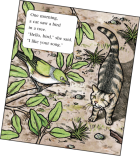
From Purr-fect! by Dot Meharry, Ready to Read (Yellow)
At Yellow level, students are developing their ability to search for and use interrelated sources of information (semantic, syntactic, and visual and graphophonic).2 They use a wider range of word-solving strategies and comprehension strategies to make or confirm meaning. They need to be able to:
- decode simple, regular words by using their knowledge of grapheme–phoneme relationships and by making analogies to known rimes
- use sentence structure and context to supplement information gained from partial decoding attempts
- understand the function of some language and punctuation features (for example, the use of pronouns and speech marks to help track dialogue between characters)
- use comprehension strategies such as forming hypotheses and making simple inferences.
Students at Yellow level enjoy discussing the texts they read and offering opinions about them. Their reading is fluent and well-phrased, and they usually read without finger pointing.
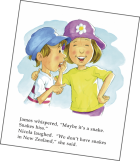
From The Hissing Bush by Trish Puharich, Ready to Read (Blue)
At Blue level, students apply their reading processing strategies to longer and more varied texts. They need to:
- monitor their reading, searching for and using multiple sources of information in order to confirm or self-correct
- recognise many high-frequency words automatically
- engage more deeply with texts (for example, by using comprehension strategies to generate their own questions or to evaluate the effectiveness of a text).
Students at this level are curious about language. They enjoy discovering new things and talking about their discoveries (for example, noticing that they can work out a compound word by recognising the components). They read some sections of text silently.
Writing
In their first year of school, students create many texts for a range of purposes across the curriculum. They plan for writing, using talk and pictures, and they attempt to record their ideas and experiences in print.
At first, there is a high level of scaffolding as teachers help students to:
- hold an idea in their head long enough to write it down
- say, hear, and record the predominant sounds in the words they want to write
- write from left to right and leave spaces between words
- form letters accurately.
Gradually, the support alters as teachers help students to build and strengthen their processing systems and to create longer, more complex texts. Students learn to:
Studies of effective teachers have shown that they continually make explicit the connections between reading and writing. Teachers who have a grasp of this reciprocal relationship recognise that writing is neither secondary to reading nor something to be taught separately from reading.
Effective Literacy Practice in Years 1 to 4, page 113
- experiment with capturing words from their oral vocabulary
- hear and say the initial and final sounds and some dominant medial sounds in the words they want to write
- recognise and identify common sounds in different words
- use their developing visual memory to consistently encode (spell) some known words correctly
- make close attempts to encode words by using their developing knowledge of phoneme–grapheme relationships, which enables them to:
- understand that words are made up of sounds and that sounds are written with letters
- write all consonant sounds, and represent some vowel sounds, in at least one way
- attempt to record the sounds within words in sequence
- make close attempts to encode words by noticing visual similarities to known words
- attempt to use capital letters and full stops as they develop their understanding of sentences
- reread what they write as they are writing and read (or retell) their writing to themselves and others.
Students in the first year of school are becoming increasingly aware of the purposes for their writing, and they use a range of text forms. They can express their ideas in increasingly interesting ways as they gain control over using more complex language structures, including varied ways of beginning sentences.
The teacher has a crucial role in assessing what students can do and targeting instruction to what they need to learn. Teachers respond to learners’ needs by intensifying instruction as necessary to ensure that all their students become successful learners.
1. Some children may have prior experiences with (and prior knowledge of) books in languages that have other conventions; for example, Arabic texts are read from right to left.
2. Refer to Effective Literacy Practice in Years 1 to 4, pages 28–31, for information about these sources of information in texts.


